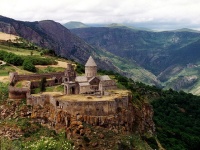Visit worldtravels.com for the full guide to Armenia. Build a complete Armenia travel guide and email to your clients - sign up for a trial subscription of World Travels Pro.
Armenia

Historically, culturally and scenically the Republic of Armenia is a captivating destination. Not only has it been acknowledged as a cradle of civilisation with centuries of ancient history to unravel, but it also boasts natural attractions aplenty and is spoilt for beauty.
Armenia was one of the first countries to adopt Christianity as its official state religion in 301 AD and many of the country's surviving ancient monuments are Christian churches and monasteries. Mt Ararat, in Turkey, was once within the borders of Armenia before the area was divided between Turkey and the USSR, and is believed to be the site of Biblical Noah's landing of the ark following the great flood. Armenians still consider the mountain, the highest in the region at 16,946 feet (5,165m), to be a symbol of their land, and it features on their national emblem today. The story of Noah's Ark is important in Judaism, Christianity and Islam.
The tiny landlocked country is part of the Southern Caucasus region sandwiched between Europe and Asia and between the Black and Caspian Seas. Present-day Armenia occupies but a fraction of the ancient Armenia, and was once a republic of the Soviet Union. Its capital, Yerevan, is one of the world's oldest cities, founded years before the founding of ancient Rome.
Armenia is largely mountainous, with the alluring Mount Ararats its highest peak at 13,435 feet (4,095m). The countryside is riddled with small lakes, and also boasts one of the world's biggest mountain lakes, Lake Sevan. The mountains are also home to health spas and treatment centres, and the Tavush region is known for its healing mineral waters where resorts such as Ijevan and Dilijan are recognised treatment centres.
The Kotayk region boasts some of Armenia's most spectacular scenery and is a popular destination for local and foreign tourists. The resort of Tsakhkadzor ('canyon of flowers') is most popular in winter with excellent skiing. Visitors to the Syunik region will find beautiful scenery and natural springs, as well as sights like the Tatev Monastery, the Stonehenge of Armenia (Karahunj), Goris and the Shake waterfall. To the north, the Lori region is sought out by campers and hikers, but also boasts two UNESCO World Heritage sites, the monasteries of Sanahin and Haghpat, as well as the Odzun Cathedral. East of Yerevan lies the spiritual centre of Armenia, the Holy See of Echmiadzin, the most significant cathedral in the world's oldest Christian nation.
Climate
Most of Armenia experiences a continental climate due to its high elevation, with hot summers and cold winters. The higher elevations receive more precipitation and are cooler. Summer is the most popular season for travellers, but spring and autumn are the best time of year to travel in Armenia with milder temperatures. Yerevan has average summer temperatures of and 23°F (-5°C) in winter, but temperatures are often more extreme.
Money
The official currency of Armenia is the Dram (AMD), which is divided into 100 lumas. Foreign currency can be exchanged at banks as well as many hotels, with US dollars the most widely recognised and easily changed, although notes should be in good condition. Credit cards are not widely accepted other than in some large hotels and restaurants. Travellers cheques should be in US dollars to avoid additional charges and there are few ATMs in Yerevan, including HSBC. It is advisable to carry plenty of small change in local currency as shops and markets will often not have change.
Passport Visa
All passports must be valid for the period of intended stay. It is recommended that all visitors requiring a visa should obtain it prior to arrival from the Armenian Embassy in their home country, however visas are obtainable for most nationalities for a tourist stay of up to four months at Yerevan Zvartnots Airport if holding sufficient funds.
Entry Requirements
- US nationals require a passport and a visa for entry to Armenia. Visas may be issued on arrival for up to 120 days.
- UK nationals require a passport and a visa for entry to Armenia. Visas may be issued on arrival for up to 120 days.
- Canadians require a passport and a visa for entry to Armenia. Visas may be issued on arrival for up to 120 days.
- Australians require a passport and a visa for entry to Armenia. Visas may be issued on arrival for up to 120 days.
- South Africans require a passport and a visa for entry to Armenia. Visas may be issued on arrival for up to 120 days.
- Irish nationals require a passport and a visa for entry to Armenia. Visas may be issued on arrival for up to 120 days.
- New Zealand nationals require a passport and a visa for entry to Armenia. Visas may be issued on arrival for up to 120 days.
Health
There are no immunizations required for travellers to Armenia; however there is a small risk of malaria between June and October in some of the villages of the Ararat Valley. Medical care is limited, particularly outside of Yerevan, and treatment is not recommended for anything major. Comprehensive medical insurance should include emergency medical evacuation.
Embassy Consulates
- Armenia Embassy, Washington DC, United States: +1 202 319 1976.
- Armenia Embassy, London, United Kingdom (also responsible for Ireland): +44 (0)20 7938 5435.
- Armenia Embassy, Ottawa, Canada: +1 613 234 3710.
Foreign Embassies
- United States Embassy, Yerevan: +374 (0)10 464 700.
- British Embassy, Yerevan: +374 (0)10 264 301.
- Canadian Embassy, Moscow, Russia (also responsible for Armenia): +7 495 105 6000.
- Australian Embassy, Moscow, Russia (also responsible for Armenia): +7 495 956 6070.
- South African Embassy, Kyiv, Ukraine (also responsible for Armenia): +380 (44) 287 7172.
- Irish Embassy, Sofia, Bulgaria (also responsible for Armenia): +359 2 985 3425.







